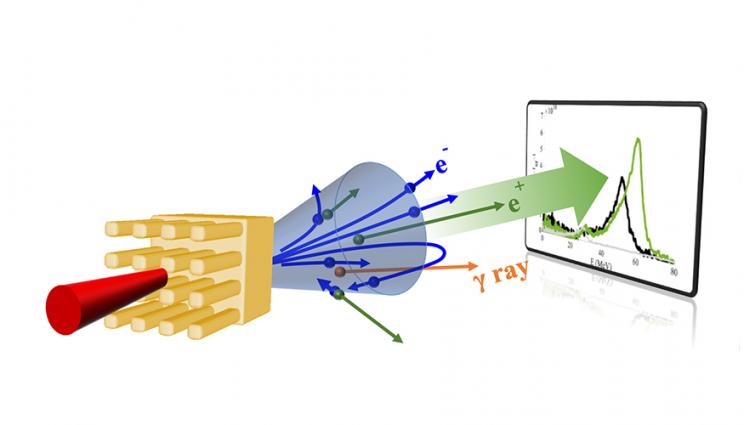
Laser light enters the micro-structure in front of the gold target, driving high energy gamma photons (orange) and particles, including the electron-positron antimatter pairs (blue and green). The experimental data shows that the micro-structure doubled the energy conversion from lasers to antimatter (relative to a target with no structure).
Lawrence Livermore National Laboratory (LLNL) scientists have achieved a near 100 percent increase in the amount of antimatter created in the laboratory.
Using targets with micro-structures on the laser interface, the team shot a high-intensity laser through them and saw a 100 percent increase in the amount of antimatter (also known as positrons). The research appears in Applied Physics Letters.
Previous research using a tiny gold sample created about 100 billion particles of antimatter. The new experiments double that.
"These successful experimental results are important for the Livermore positron project, whose grand goal is to make enough electron-positron antimatter to study the physics of gamma-ray bursts," said Hui Chen, the project lead and a co-author of the paper. "But we found that the experiments also created a high energy (MeV) X-ray backlighter that can penetrate very dense objects, which is important for many aspects of high energy density science."
When enough energy is squeezed into a very small space, such as during high-energy particle collisions, particle-antiparticle pairs are produced spontaneously. When energy transforms into mass, both matter and antimatter are created in equal amounts. In these experiments, intense laser-plasma interactions produce very high energy electrons whose energy, when interacting with the gold target, can generate electron-positron pairs.
The researchers used previous results and new simulations to design micro-structures, which could either enhance or diminish this interaction, leading to enhanced or suppressed positron generation relative the previous state of the art. Co-author Anthony Link said that "the agreement between the simulations and the experiment is remarkable, giving us confidence that we're capturing the most important physical mechanisms."
The ability to create numerous positrons in a small laboratory opens the door to new avenues of anti-matter research, including an understanding of the physics underlying various astrophysical phenomena such as black holes and gamma-ray bursts as well as a pathway toward a dense electron-positron plasma in the laboratory.
"Adding front surface micro-structures to the typical gold target constitutes a cost-effective approach to substantially increase the positron yield while keeping the same laser conditions. It is one step further toward using laser-generated positron sources for the variety of applications," said Jiang Sheng, the lead author of the paper.
Other Livermore scientists include Shaun Kerr, Russell Wallace and Jackson Williams as well as researchers from the Laboratory for Laser Energetics at Rochester, General Atomics, California Institute of Technology and the University of California, San Diego. The research was funded by LLNL's Laboratory Directed Research and Development program.






